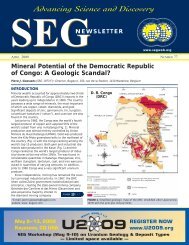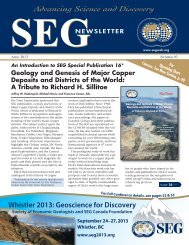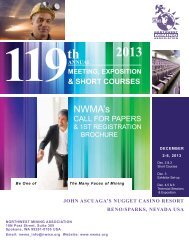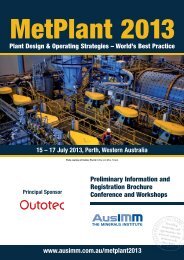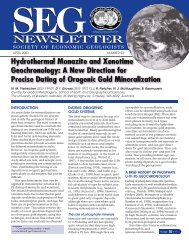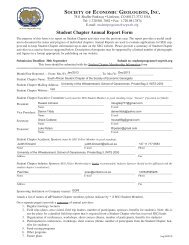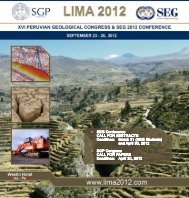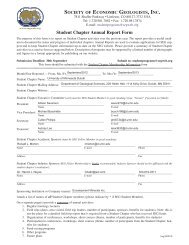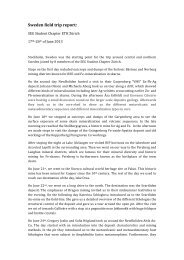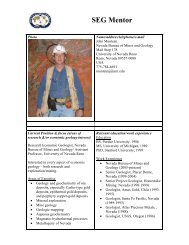SEG - Society of Economic Geologists
SEG - Society of Economic Geologists
SEG - Society of Economic Geologists
Create successful ePaper yourself
Turn your PDF publications into a flip-book with our unique Google optimized e-Paper software.
JULY 2012 • No 90 <strong>SEG</strong> NEWSLETTER 33<br />
<strong>Society</strong> <strong>of</strong> <strong>Economic</strong> <strong>Geologists</strong> Foundation<br />
Student-Dedicated Field Course • Iberian Pyrite Belt<br />
May 12–18, 2012<br />
WILLIAM X. CHÁVEZ, JR. (<strong>SEG</strong> 1990 F) AND ERICH U. PETERSEN (<strong>SEG</strong> 1986 F)<br />
The <strong>Society</strong> <strong>of</strong> <strong>Economic</strong> <strong>Geologists</strong><br />
Foundation held its ninth Student-<br />
Dedicated Field Course, with emphasis<br />
on the regional characteristics <strong>of</strong> volcanogenic<br />
massive sulfide (VMS) systems<br />
<strong>of</strong> the Iberian Pyrite Belt (IPB). Sixteen<br />
students, representing eight countries,<br />
as well as four pr<strong>of</strong>essionals serving as<br />
mentors to the students, participated in<br />
the field course. The importance <strong>of</strong><br />
these <strong>of</strong>ferings to the <strong>SEG</strong> Foundation<br />
mission to provide opportunities for<br />
students to observe ore deposits features<br />
first-hand is reflected in the fact that<br />
more than 50 students applied for this<br />
course, as well a dozen pr<strong>of</strong>essionals.<br />
Starting in Lisboa, we traveled along<br />
the strike <strong>of</strong> the IPB across Portugal and<br />
Spain, arriving in the Arecena area for<br />
our first visit: the mid-1990s discovery<br />
comprising the Las Cruces VMS system.<br />
Producing approximately 72 kt/yr <strong>of</strong><br />
cathode copper, Las Cruces is one <strong>of</strong><br />
the largest copper mines in Europe, and<br />
our discussions centered on the discovery<br />
history <strong>of</strong> the deposit, as well as the<br />
advantages <strong>of</strong> copper recovery using<br />
hydrometallurgical methods, one <strong>of</strong> the<br />
few mines in the IPB to do so.<br />
Aguas Teñidas, a polymetallic VMS<br />
system producing Cu, Zn, and Pb concentrates<br />
from massive and stockworkstyle<br />
ores, was our next visit, and provided<br />
the opportunity for participants<br />
to observe variations in VMS<br />
ore styles and metal contents.<br />
Ore production is from a series<br />
<strong>of</strong> underground orebodies, each<br />
having distinct metal contents<br />
and metal ratios; by means <strong>of</strong><br />
these, we were introduced to<br />
the complexities <strong>of</strong> ore segregating<br />
and processing, and the<br />
necessity <strong>of</strong> producing highquality<br />
concentrates for competitive<br />
marketing. Review <strong>of</strong><br />
core provided the opportunity<br />
to see sedimentary features<br />
that characterize the ore-host<br />
Devonian-age rock units <strong>of</strong> the<br />
Aguas Teñidas mine area.<br />
Traveling back to Portugal<br />
along the southern part <strong>of</strong> the<br />
belt, our following visit was to<br />
the largest metal-producing<br />
mine in western Europe, the<br />
polymetallic Neves Corvo<br />
mine operated by Lundin<br />
(SOMINCOR). Partici pants<br />
were split into two groups,<br />
with one group visiting the<br />
underground mine, while<br />
another toured the extensive<br />
concentrator operations;<br />
this division allowed<br />
students to see the de tailed<br />
mine-to-mill operations<br />
that process complex ores<br />
derived from more than 80<br />
underground faces. We<br />
learned that infill drill hole<br />
spacings <strong>of</strong> 17.5 m were<br />
necessary to effectively<br />
understand ore grade and<br />
metal distributions, making<br />
Neves Corvo one <strong>of</strong> the most densely<br />
drilled orebodies in the world.<br />
The Aljustrel mine, representing the<br />
westernmost producing ore district in<br />
the IPB, is a polymetallic Cu-Zn VMS<br />
system that currently produces approximately<br />
70kt/yr <strong>of</strong> copper concentrates;<br />
formerly emphasizing zinc production<br />
and potential, the Aljustrel mine now is<br />
the second largest producer <strong>of</strong> copper<br />
in the Portugal section <strong>of</strong> the belt. Out<br />
visit involved both underground and<br />
concentrator visits, reinforcing the need<br />
to understand both complex mine geology<br />
and ore metallurgical characteristics<br />
Field course participants listen to Joáo Matos <strong>of</strong> the<br />
Portuguese Geological Survey describe local stratigraphy<br />
near the westernmost known margin <strong>of</strong> the IPB in Portugal.<br />
Joáo is describing the local VMS environment on properties<br />
being explored by Paul Kuhn and the Avrupa Minerals-<br />
Participants listen to a geology presentation at the Aguas<br />
Teñidas polymetallic VMS mine, southwestern Spain. All IPB<br />
mines provided detailed discussions <strong>of</strong> regional and mine geology,<br />
emphasizing the stratigraphic occurrences <strong>of</strong> massive sulfides<br />
and regional structural considerations.<br />
in order to produce a market-competitive<br />
ore concentrate.<br />
Our final day was spent reviewing<br />
exploration characteristics <strong>of</strong> the IPB,<br />
with a visit to the Avrupa Minerals<br />
exploration programs near the westernmost<br />
known margin <strong>of</strong> the belt, in the<br />
Lousal-Grándola area. Paul Kuhn and<br />
the Avrupa Minerals exploration team<br />
discussed exploration ideas and concepts<br />
within this section <strong>of</strong> the belt and<br />
included a visit to an exploration drill<br />
rig testing the stratigraphic sequence<br />
known to host VMS bodies in the Lousal<br />
region. Following the exploration review,<br />
Joáo Matos <strong>of</strong> the Portugal Geological<br />
Survey conducted a visit to the Lousal<br />
Life Science Center at the former Lousal<br />
pyrite mine. The Portuguese government<br />
and Survey have converted the<br />
former mine area into an educational<br />
center, discussing the importance <strong>of</strong><br />
mining, the environment, and regional<br />
sustainability issues. Joáo discussed the<br />
complexities <strong>of</strong> this portion <strong>of</strong> the IPB,<br />
and recent advances in understanding<br />
the tectonostratigraphic nature <strong>of</strong> the<br />
sedimentary sequences in this region,<br />
especially the ore-host horizons.<br />
Our traditional farewell dinner, back<br />
in Lisboa, allowed participants to review<br />
our visits to the IPB and to establish contacts<br />
for future discussions and continued<br />
pr<strong>of</strong>essional-student interactions. These<br />
end-<strong>of</strong>-course dinners also provide the<br />
opportunity for the <strong>SEG</strong>F<br />
to present certificates to<br />
Ant<strong>of</strong>agasta Minerals joint venture exploration team. to page 34 ...<br />
STUDENT NEWS



